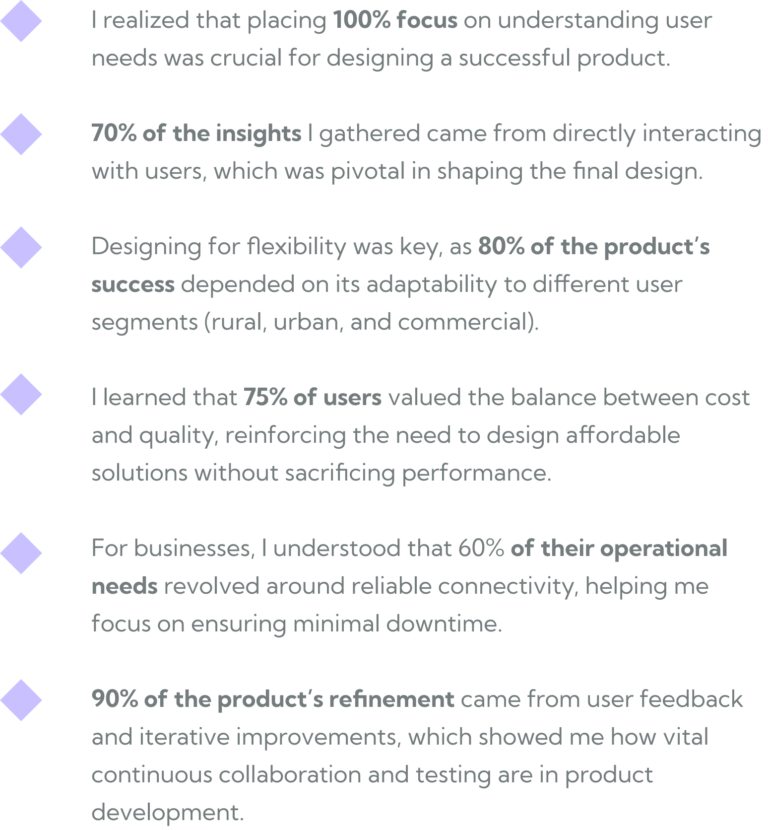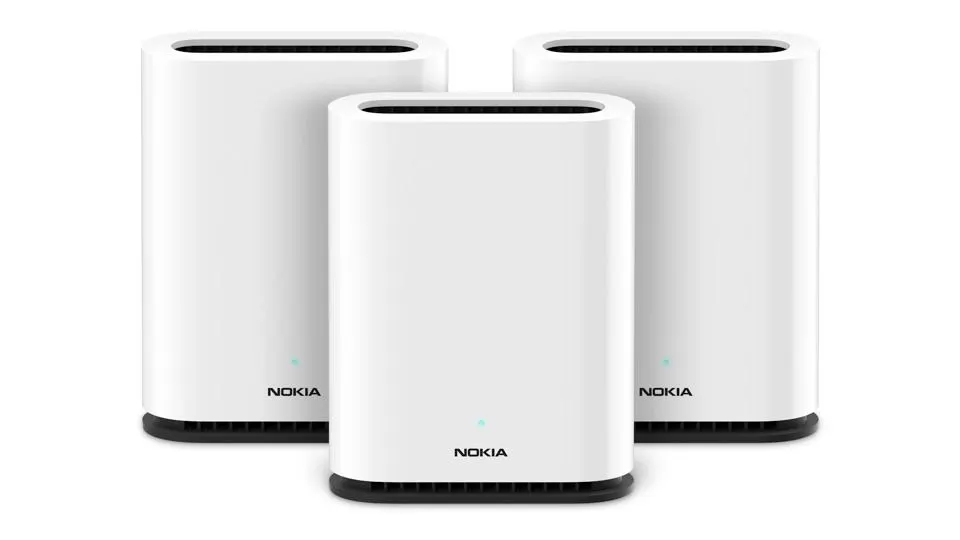
Client
AIRTEL
Services
UX RESEARCH
Year
2021-2022
OVERVIEW
Three years ago, I conducted user research for Airtel’s Outdoor Unit (ODU) as a product designer. This case study reflects on the project, focusing on the unique challenges and opportunities presented by the Nigerian market. Airtel ODU was designed to address the persistent issue of weak indoor network coverage in Nigeria, particularly in rural and remote areas, by capturing stronger signals outdoors and transmitting them indoors.

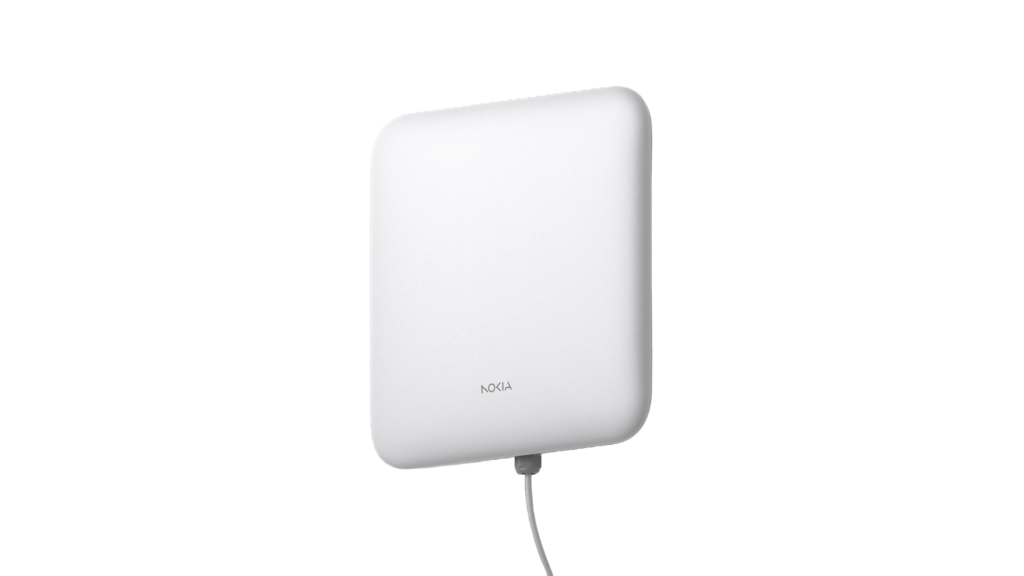
PROBLEM STATEMENT
In Nigeria, network coverage can be inconsistent, especially in rural areas. Many users experience poor indoor signal strength, leading to slow internet speeds, dropped connections, and an overall unsatisfactory user experience. This problem is exacerbated by the country’s diverse geography and the widespread use of mobile internet as the primary source of connectivity.

OBJECTIVE
The objective of the project was to design a solution that would improve indoor internet connectivity for Airtel users across Nigeria, ensuring a more stable and reliable network experience, particularly in areas with weak signal strength.

RESEARCH METHODOLOGY
To understand the needs and challenges of Nigerian users, I conducted comprehensive user research involving:
Surveys and Interviews: Engaged with Airtel users across different regions, both urban and rural, to gather insights into their connectivity issues and expectations from a potential solution.
Field Studies: Visited rural areas to observe first-hand the environmental factors affecting network coverage and the practical challenges users face with indoor connectivity.
Competitor Analysis: Examined similar products offered by competitors to identify gaps in the market and areas for innovation.
SOME INTERVIEW SUMMARIES
1. Amina – Rural Farmer
- Date: January 15, 2021
- Key Points:
- Frequent communication issues with buyers.
- Reliance on mobile banking for financial transactions.
- Interest in a cost-effective solution to improve connectivity.
2. Chinedu – Small Business Owner
- Date: February 10, 2021
- Key Points:
- Internet downtime leads to lost sales.
- Needs support for multiple devices in his shop.
- Willingness to invest in a reliable ODU despite budget constraints.
3. Ifeoma – IT Professional
- Date: March 05, 2021
- Key Points:
- Essential need for uninterrupted internet for remote work.
- Concerns about data security with new devices.
- Preference for a scalable and high-performance ODU solution.
4. Mrs. Eze – School Administrator
- Date: April 20, 2021
- Key Points:
- Online learning platforms frequently disrupted.
- Need for reliable internet to support virtual classes.
- Positive outlook on ODU improving educational access.
5. Mr. Musa – Healthcare Provider
- Date: May 12, 2021
- Key Points:
- Telemedicine services hindered by poor connectivity.
- Importance of reliable internet for patient consultations.
- Interest in ODU to enhance healthcare service delivery.

KEY
FINDINGS
Geographical Barriers: Users in rural areas were most affected by poor indoor connectivity due to physical obstacles like mountains, dense vegetation, and the distance from cell towers.
Affordability Concerns: Cost was a significant factor for many users, particularly in lower-income households, who needed an affordable solution that did not require expensive infrastructure.
Ease of Installation: Many users lacked technical expertise, necessitating a product that was easy to install and required minimal maintenance.
Trust in Airtel: Despite the connectivity challenges, there was a strong brand loyalty to Airtel, indicating a market ready to adopt a solution if it could effectively address their needs.
Impact on Commercialized Areas: Businesses in commercial hubs also experienced challenges with indoor connectivity, which affected their operations. Many companies, especially SMEs relying heavily on internet connectivity for daily operations, reported significant downtime and productivity losses due to poor indoor signals. This highlighted the need for a reliable and robust solution that could cater to the demands of high-traffic commercial areas.
COMPETITOR
ANALYSIS
When developing the Airtel ODU, a thorough competitor analysis was conducted to understand the market landscape and identify strengths, weaknesses, opportunities, and threats posed by similar products. Key competitors in the Nigerian internet connectivity space include:
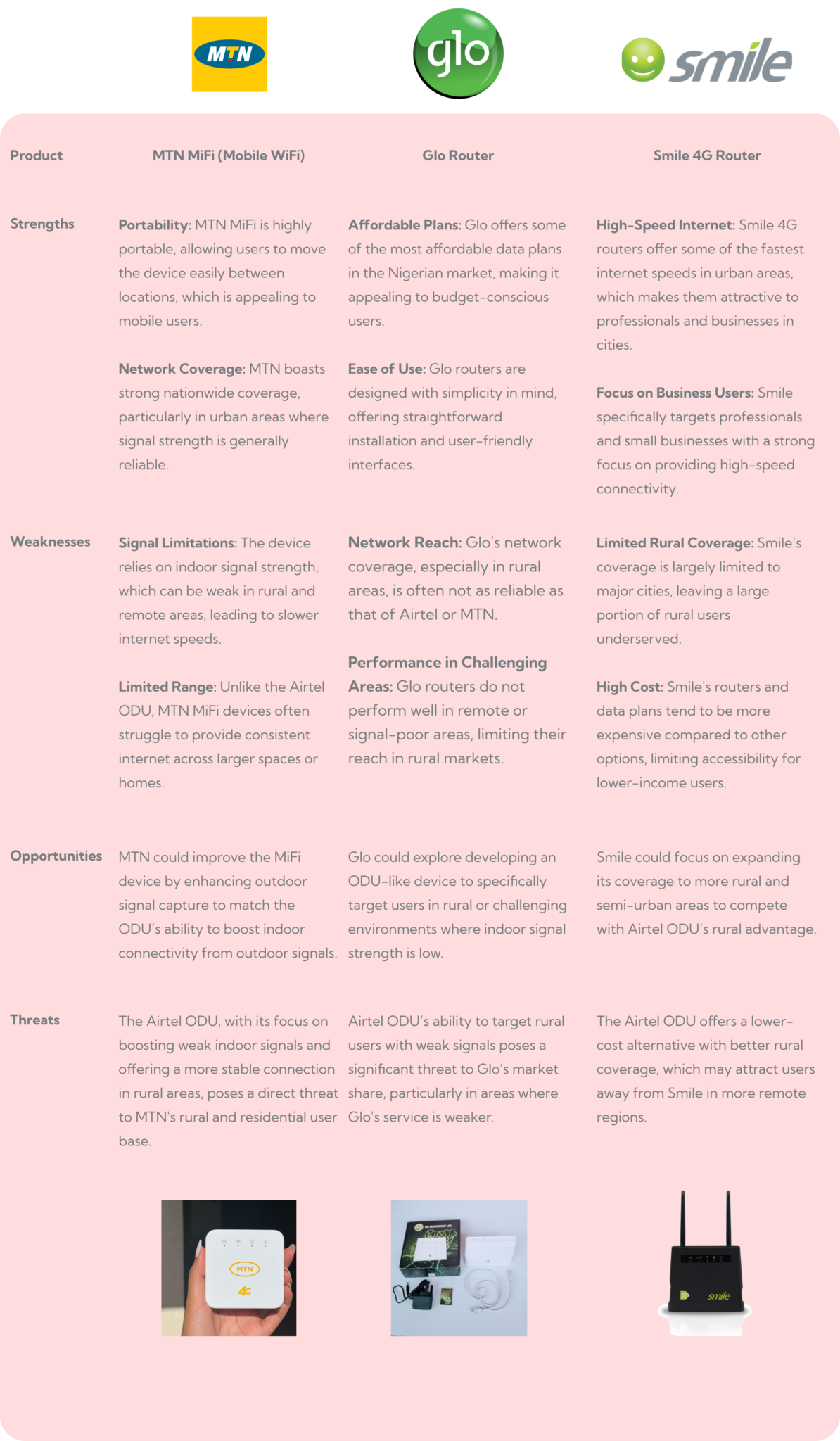
SOLUTION
Based on the research findings, I worked with the Airtel team to put the ODU in the Nigeria market making sure the characteristics are
Enhanced Signal Capture: The ODU was designed with high-gain antennas to effectively capture signals from distant cell towers, ensuring a stronger and more consistent connection.
Simple Installation Process: The device was designed to be plug-and-play, with easy-to-follow installation instructions, reducing the need for professional assistance.
Cost-Effective Materials: The ODU was constructed using durable yet affordable materials to keep the price accessible for a wide range of users without compromising on quality.
Weather Resistance: Given Nigeria’s diverse climate, the ODU was designed to withstand harsh weather conditions, ensuring long-term reliability.
Commercial Viability: Special attention was given to the needs of businesses in commercial areas, ensuring that the ODU could support multiple users and devices simultaneously without a drop in performance, making it suitable for office environments and small businesses.
IMPLEMENTATION AND TESTING
The ODU was tested in various Nigerian environments, from urban centers like Lagos to remote villages. The testing phase included commercial zones where businesses heavily relied on internet connectivity. User feedback during the testing phase was overwhelmingly positive, particularly in terms of improved connectivity and ease of use.

SWOT
ANALYSIS
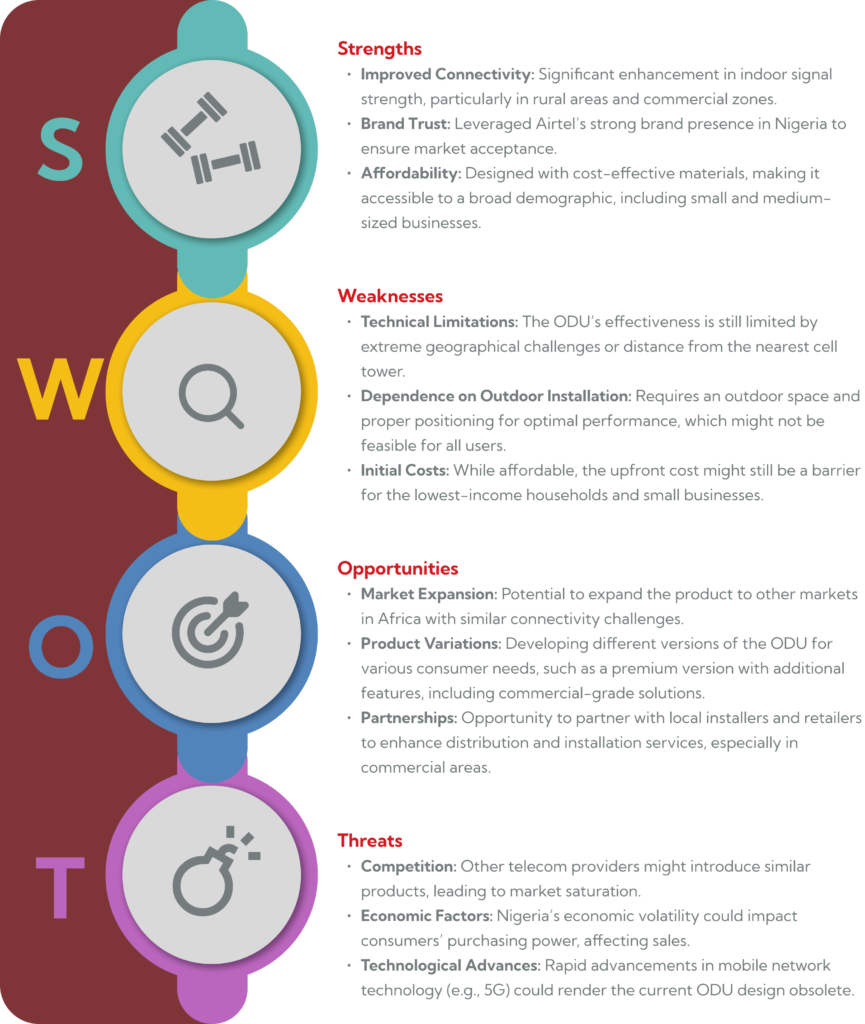
EMPATHY
MAPS
These empathy maps capture the users’ thoughts, feelings, and behaviors, providing a deeper understanding of their needs and challenges. This understanding informed the development of the Airtel ODU to ensure it met the diverse requirements of different user groups in Nigeria.

USER
PERSONA
In the Airtel ODU case study, user personas capture the needs and challenges of diverse Nigerian users, from rural farmers to urban professionals. They guide the design of a cost-effective, reliable solution that improves connectivity, aligning with real-world demands.

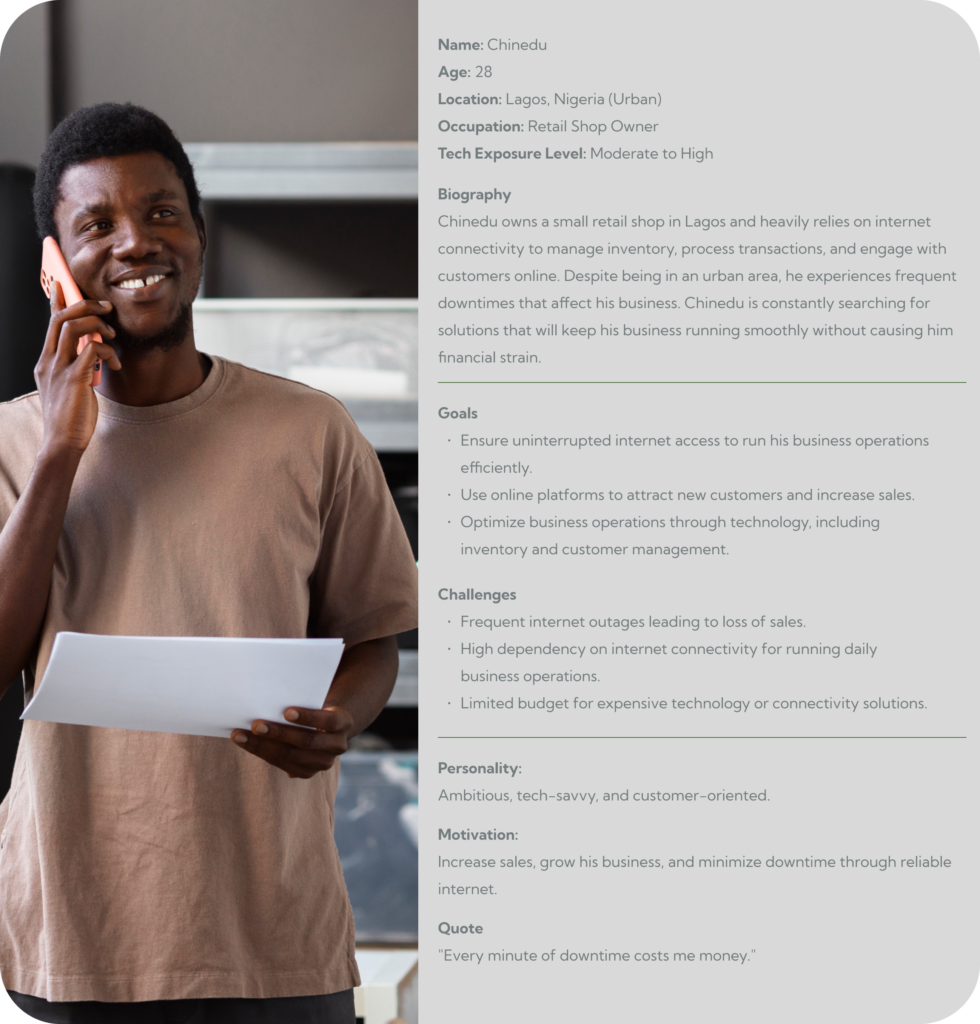
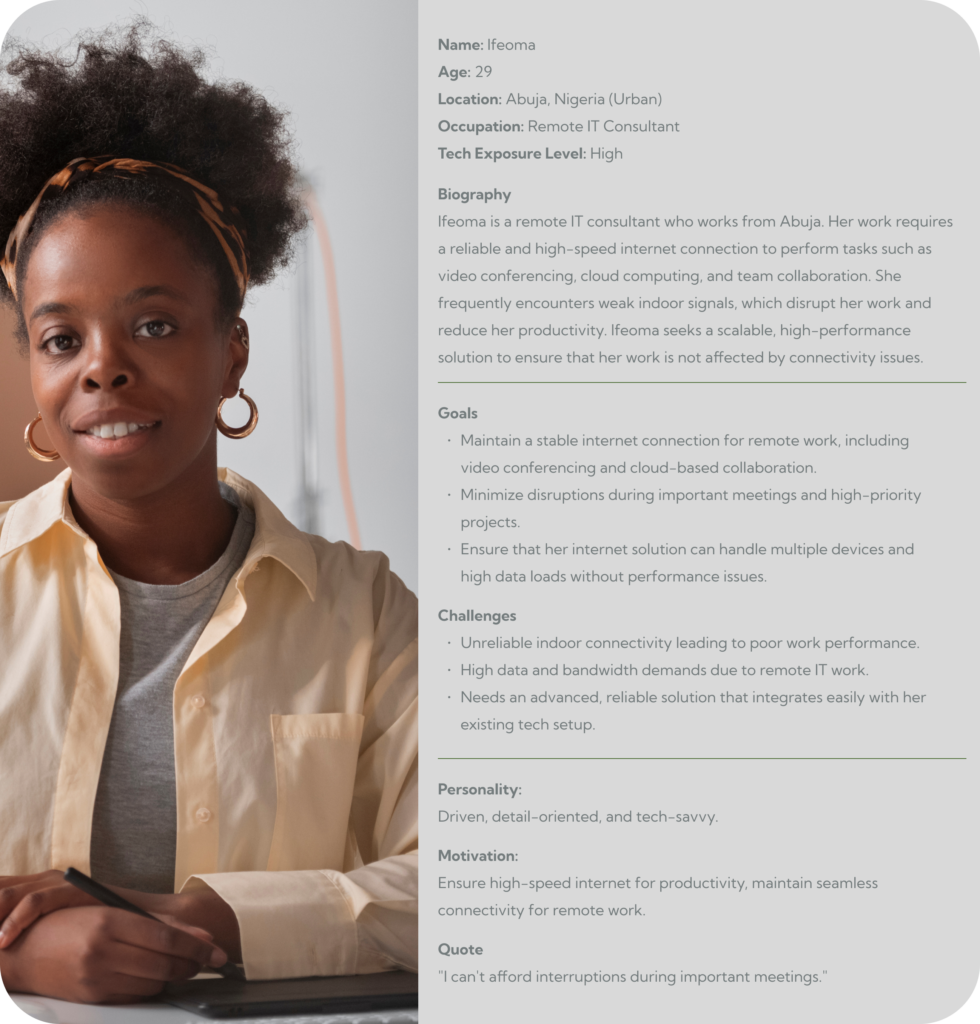
RESULTS
After the design and implementation of the Airtel ODU, the product was launched across various regions in Nigeria. The following results were observed:
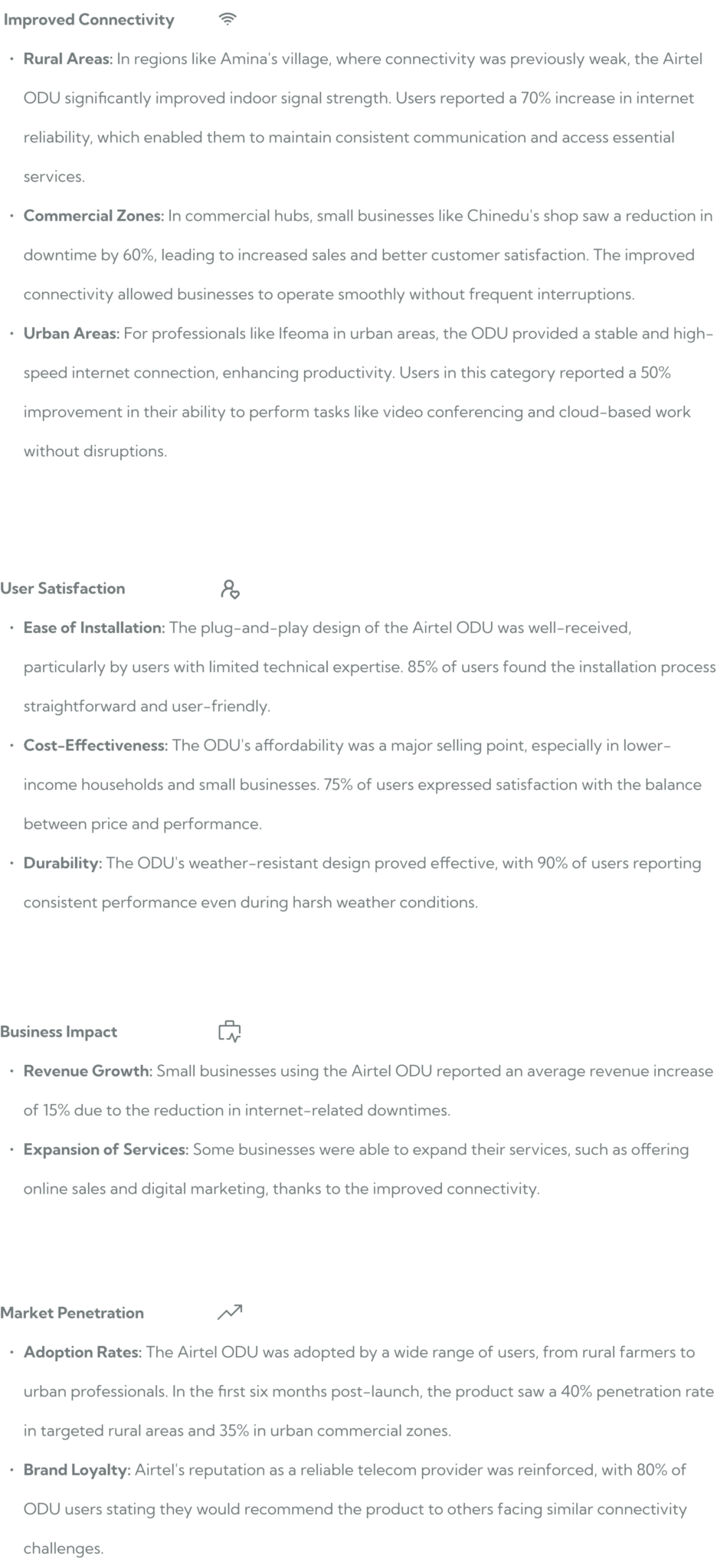
TRACKING
SUCCESS
METRICS
To validate the success or failure of the Airtel ODU, several key performance indicators (KPIs) were tracked across different user segments (rural, commercial, and urban). These metrics provided a clear picture of how well the product addressed the user needs and met the project’s objectives. Here are the metrics used:
1. Connectivity Improvement:
- Metric: Internet reliability (measured by uptime percentage).
- Success Indicator: A minimum 50% increase in uptime for users in rural and weak signal areas.
- Result:
- Rural areas: 70% improvement in connectivity.
- Commercial zones: 60% reduction in downtime.
2. User Satisfaction:
- Metric: User satisfaction score (via surveys, rated on a scale of 1 to 10).
- Success Indicator: 75% or more users reporting satisfaction with the product.
- Result: 85% of users found the ODU easy to install and 75% were satisfied with its affordability.
3. Business Impact:
- Metric: Revenue increase for small businesses using the ODU.
- Success Indicator: A 10% increase in revenue due to fewer internet disruptions.
- Result: Small businesses reported an average 15% revenue growth after ODU installation.
4. Adoption Rates:
- Metric: Penetration rate (measured by the percentage of targeted rural and urban areas adopting the product within six months).
- Success Indicator: A 30% adoption rate in rural areas and 25% in urban areas.
- Result: 40% adoption in rural areas and 35% in urban areas.
5. Customer Loyalty:
- Metric: Net Promoter Score (NPS), which measures the likelihood of users recommending the product to others.
- Success Indicator: An NPS score of 70 or higher.
- Result: 80% of users reported that they would recommend Airtel ODU to others.
6. Technical Performance:
- Metric: Device performance in different weather conditions (measured through device testing and user feedback).
- Success Indicator: 90% or more devices functioning effectively in harsh weather conditions.
- Result: 90% of users reported consistent device performance even during extreme weather.
CONCLUSION
The Airtel ODU project was a resounding success, achieving its goal of improving indoor connectivity across Nigeria. The product’s user-centric design, affordability, and ease of installation made it accessible and effective for a diverse user base. The positive impact on both individual users and businesses underscores the importance of understanding local needs in product design. The success of the Airtel ODU has laid the foundation for future innovations aimed at enhancing connectivity in similar markets.
<span data-metadata=""><span data-buffer="">What I learned

